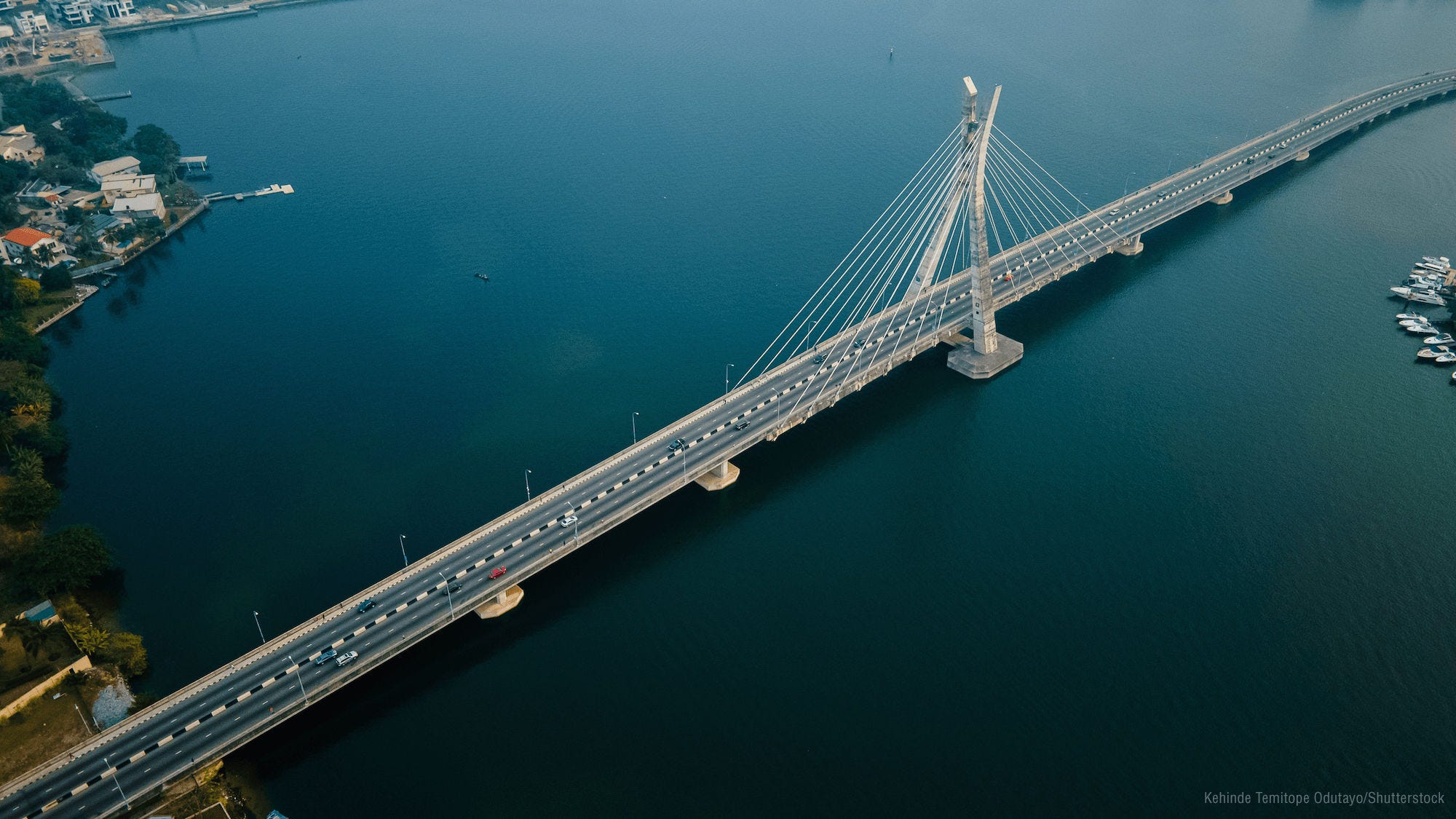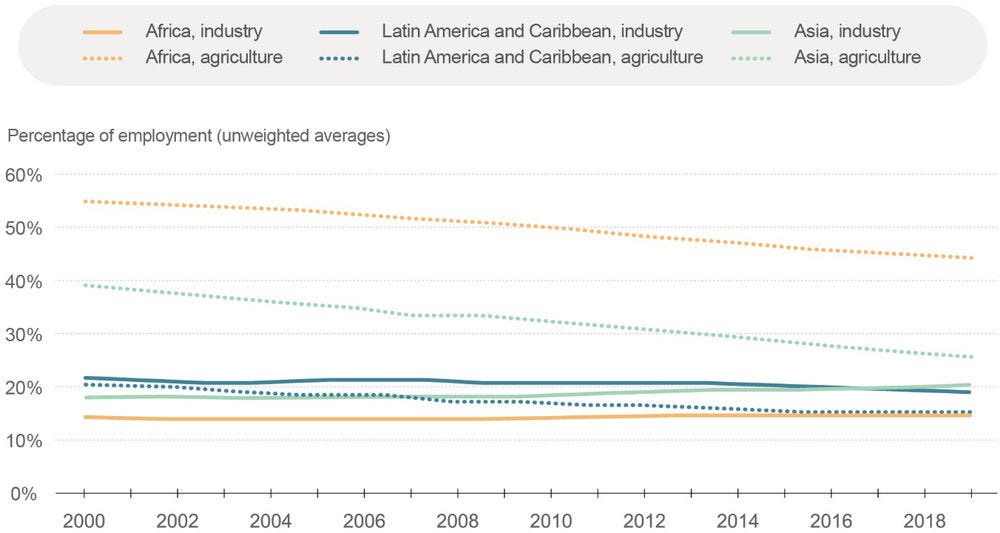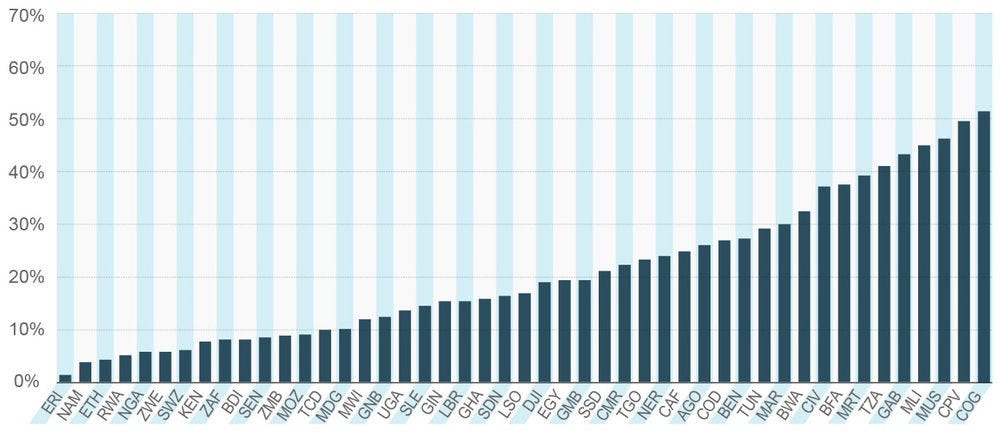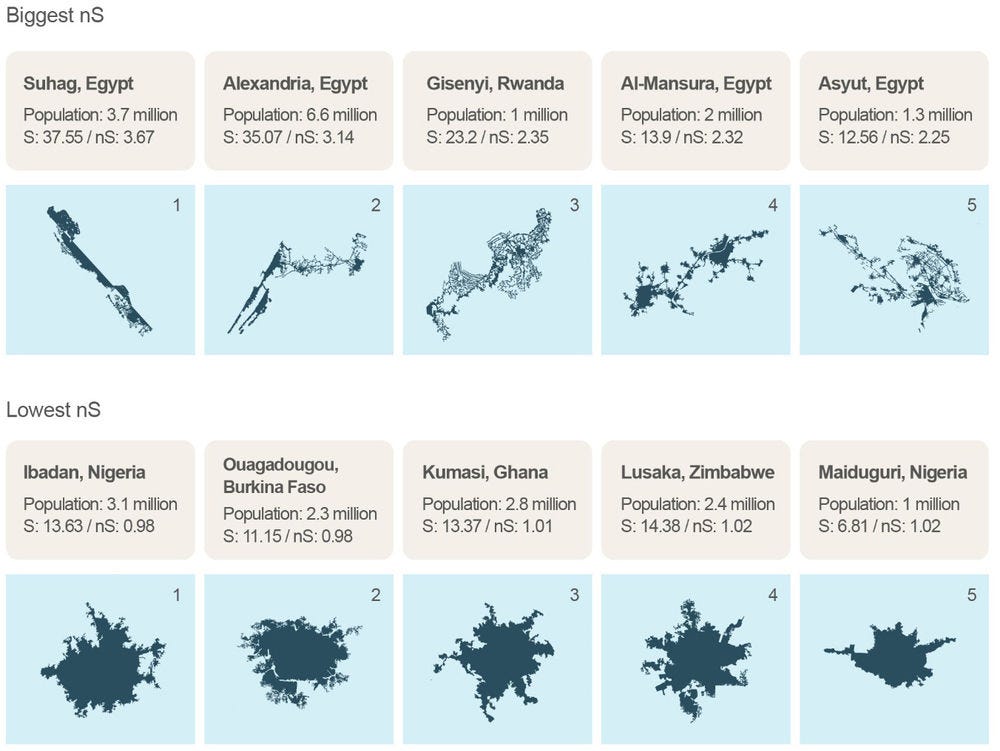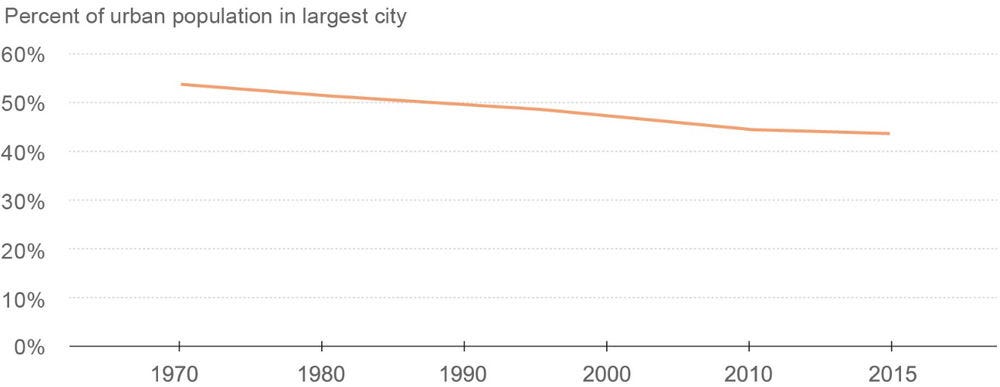[70] Abdel-Rahman, H. and F. Masahita (1990), “Product Variety, Marshallian Externalities, and City Sizes”, Journal of Regional Science, Vol. 2, pp. 165-183.
[63] Acemoglu, D., S. Johnson and J. Robinson (2001), The Colonial Origins of Comparative Development: An empirical investigation, National Bureau of Economic Research, https://www.nber.org/system/files/working_papers/w7771/w7771.pdf.
[10] AfDB (2018), “Growth, Jobs and Poverty in Africa”, African Development Bank.
[35] AfDB/OECD/UNDP (2016), African Economic Outlook 2016: Sustainable cities and structural transformation, OECD Publishing, Paris.
[121] Affairs, U. (ed.) (2018), World Urbanization Prospects 2018, https://population.un.org/wup/.
[36] Amirtahmasebi, R. (2016), Leveraging Urbanization and Governance for Growth in Africa: A framework for action, UNDP and UN-Habitat, New York.
[104] Andreasen, M. et al. (2020), “Informal land investments and wealth accumulation in the context of regularization: case studies from Dar es Salaam and Mwanza”, Environment and Urbanization, Vol. 32/1, pp. 89-108, https://doi.org/10.1177/0956247819896265.
[37] Andres, L., D. Biller and M. Herrera Dappe (2015), A Methodological Framework for Prioritizing Infrastructure Investment, World Bank, Washington, DC.
[98] Angel, S. (2011), Making Space for a Planet of Cities, Lincoln Institute of Land Policy.
[97] Angel, S., J. Parent and D. Civico (2010), “Ten compactness properties of circles: measuring shape in geography”, The Canadian Geographer / Le Géographe canadien, Vol. 54/4, pp. 441-461, https://doi.org/10.1111/j.1541-0064.2009.00304.x.
[49] Arnold, J., A. Mattoo and G. Narciso (2006), Services Inputs and Firm Productivity in Sub-Saharan Africa: Evidence from firm-level data, World Bank, Washington, DC.
[13] Asmal, Z., H. Bhorat and J. Page (2020), Exploring New Sources of Large-Scale Job Creation: The potential role of industries without smokestacks, Brookings Institution, Washington DC.
[50] Aterido, R. and M. Hallward-Driemeier (2007), Impact of Access to Finance, Corruption and Infrastructure on Employment Growth: Does Sub-Saharan Africa mirror other low-income regions, World Bank, Washington, DC.
[51] Aterido, R., M. Hallward-Driemeier and C. Pagés (2007), Business Climate and Employment Growth: The impact of access to finance, corruption and regulations across firms, Institute for the Study of Labor, Bonn.
[88] Bacolod, M., B. Blum and W. Strange (2009), “Skills in the City”, Journal of Urban Economics, Vol. 65/2, pp. pp. 136-153.
[52] Bacon, R. and M. Kojima (2016), Energy, Economic Growth, and Poverty Reduction: A literature review, World Bank, Washington, DC.
[14] Barro, R. (2001), “Human Capital and Growth”, American Economic Review, Vol. 91/2, pp. 12-17.
[84] Bartik, T. and N. Sotherland (2019), Local Job Multipliers in the United States: Variation with local characteristics and with high-tech shocks, W. E. Upjohn Institute for Employment Research, Kalamazoo, Michigan.
[53] Bastos, F. and J. Nasir (2004), Productivity and the Business Climate: What matters most?, World Bank, Washington, DC.
[99] Bernard, L., J. Bird and A. Venables (2016), The Urban Land Market: A computable equilibrium model applied to Kampala City, Department for International Development, London.
[38] Boopen, S. (2006), “Transport Infrastructure and Economic Growth: Evidence from Africa using dynamic panel estimates”, The Empirical Economics Letters, Vol. 5/1.
[102] Brasselle, A., F. Gaspart and J. Platteau (2002), “Land tenure security and investment incentives: puzzling evidence from Burkina Faso”, Journal of Development Economics, Vol. 67/2, pp. 373-418, https://doi.org/10.1016/s0304-3878(01)00190-0.
[12] CAHF (2017), Housing Finance in Africa: A review of some of Africa’s housing finance markets..
[17] Calderón, C., E. Moral-Benito and L. Servén (2011), Is Infrastructure Capital Productive?: A dynamic heterogeneous approach, World Bank, Washington, DC.
[15] Calderón, C. and L. Servén (2010a), Infrastructure and Economic Development in Sub-Saharan Africa, World Bank, Washington, DC.
[16] Calderón, C. and L. Servén (2010b), Infrastructure in Latin America, World Bank, Washington, DC.
[107] Camagni, R., R. Capello and A. Caragliu (2016), “Static vs. Dynamic Agglomeration Economies”, Papers in Regional Science, Vol. 95/1, pp. pp. 133-158.
[113] Campbell, K. (2018), Making Massive Small Changes, Chelsea Green Publishing, London.
[18] Chauvin, J. et al. (2017), “What is Different About Urbanization In Rich and Poor Countries?: Cities in Brazil, China, India and the United States”, Journal of Urban Economics, Vol. 98/C, pp. 17-49.
[19] Chen, D. and C. Dahlman (2004), Knowledge and Development: A cross-section approach, World Bank, Washington, DC.
[2] Collier, P. (2017), “African Urbanization: An analytic policy guide”, Oxford Review of Economic Policy, Vol. 33/3, pp. 405-437.
[39] Collier, P. (2016), African Urbanisation: An analytic policy guide, International Growth Centre, London.
[119] Collier, P., M. Blake and P. Manwaring (2018), Making the Most of the Urban Land, International Growth Centre.
[40] Combes, P. and L. Gobillon (2015), “The Empirics of Agglomeration Economies”, in Handbook of Regional and Urban Economics, Elsevier, https://doi.org/10.1016/b978-0-444-59517-1.00005-2.
[20] Commission on Growth and Development (2008), The Growth Report: Strategies for sustained growth and inclusive development, World Bank, Washington, DC.
[108] Deichmann, U. et al. (2005), Agglomeration, Transport, and Regional Development in Indonesia, World Bank, Washington, DC.
[95] Dempsey, N. et al. (2008), “Elements of Urban Form”, in Future City, Sustainable City Form, Springer Netherlands, Dordrecht, https://doi.org/10.1007/978-1-4020-8647-2_2.
[4] Desiere, S. and D. Jolliffe (2018), “Land productivity and plot size: Is measurement error driving the inverse relationship?”, Journal of Development Economics, Vol. 130, https://doi.org/10.1016/j.jdeveco.2017.10.002.
[54] Dethier, J., M. Hirn and S. Straub (2010), “Explaining Enterprise Performance in Developing Countries with Business Climate Survey Data”, World Bank Research Observer.
[80] Diao, X. et al. (2021), Africa’s Manufacturing Puzzle: Evidence from Tanzanian and Ethiopian Firms, https://drodrik.scholar.harvard.edu/files/dani-rodrik/files/africasmanufacturingpuzzle.pdf.
[69] Dinh, H., D. Mavridis and H. Nguyen (2012), The Binding Constraint on the Growth of Firms in Developing Countries, World Bank, Washington, DC.
[21] Dinh, H. et al. (2012), Light Manufacturing in Africa: Targeted policies to enhance private investment and create jobs, World Bank, Washington, DC.
[22] Dollar, D., M. Hallward-Driemeier and T. Mengistae (2005), Investment Climate and Firm Performance in Developing Countries, Economic Dvelopment and Cultural Change, https://core.ac.uk/download/pdf/187584145.pdf.
[105] Do, Q. and L. Iyer (2008), “Land Titling and Rural Transition in Vietnam”, Economic Development and Cultural Change, Vol. 56/3, pp. 531-579, https://doi.org/10.1086/533549.
[106] Duranton, G. (2015), “Growing Through Cities in Developing Countries”, World Bank Research Observer, pp. 39-73, https://openknowledge.worldbank.org/handle/10986/24808 License: CC BY-NC-ND 3.0 IGO.
[90] Eeckhout, J., R. Pinheiro and K. Schmidheiny (2014), “Spatial Sorting”, Journal of Political Economy, Vol. 122/3, pp. pp 554-620.
[55] Escribano, A. and J. Guasch (2005), Assessing the Impact of the Business Climate on Productivity Using Firm Level Data: Methodology and the cases of Guatemala, Honduras and Nicaragua, World Bank, Washington, DC.
[41] Escribano, A., J. Guasch and J. Pena (2010), Assessing the Impact of Infrastructure Quality on Firm Productivity in Africa: Cross-country comparisons based on investment climate surveys from 1999 to 2005, World Bank, Washington, DC.
[101] Field, E. (2007), “Entitled to Work: Urban property rights and labor supply in Peru”, The Quarterly Journal of Economics, Vol. 122/4, pp. 1561-1602.
[68] Fisman, R. and J. Svennson (2007), “Are Corruption and Taxation Really Harmful to Growth?: Firm level evidence”, Journal of Development Economics, Vol. 83, pp. 63-75.
[122] Florczyk, A. (2019), Description of the GHS Urban Centre Database 2015, https://doi.org/10.2760/037310.
[117] Foster, V. and C. Briceno-Garmendia (2010), Africa’s Infrastructure : A Time for Transformation : A Time for Transformation, https://openknowledge.worldbank.org/handle/10986/2692.
[8] Fullerton, H. (1997), Economic Development and Growth of Cities: A retrospective synthesis, https://digitalcommons.usu.edu/cgi/viewcontent.cgi?article=2244&context=appecon_facpub.
[103] Galiani, S. and E. Schargrodsky (2010), “Property rights for the poor: Effects of land titling”, Journal of Public Economics, Vol. 94/9-10, pp. 700-729, https://doi.org/10.1016/j.jpubeco.2010.06.002.
[75] Gelb, A. et al. (2020), “Can Sub-Saharan Africa Be a Manufacturing Destination?: Labor costs, price levels, and the role of industrial policy”, Journal of Industry, Competition and Trade, Vol. 20, pp. pp. 335-357.
[118] Glaeser, E. and M. Resseger (2010), “THE COMPLEMENTARITY BETWEEN CITIES AND SKILLS”, Journal of Regional Science, Vol. 50/1, pp. 221-244, https://doi.org/10.1111/j.1467-9787.2009.00635.x.
[87] Glaeser, E. and M. Resseger (2010), “The Complementary Between Cities and Skills”, Journal of Regional Science, Vol. 50/1, pp. 221-244.
[86] Glaeser, E. and W. Xiong (2017), “Urban Productivity in the Developing World”, Oxford Review of Economic Policy, Vol. 33/3, pp. 373-404.
[71] Gollin, D., R. Jedwab and D. Vollrath (2016), “Urbanization With and Without Industrialization”, Journal of Economic Growth, Vol. 21, pp. 35-70.
[116] Graff, T. (2018), Spatial Inefficiencies in Africa’s Trade Network, University of Oxford, Oxford, https://ideas.repec.org/p/csa/wpaper/2018-17.html.
[76] Grover, A., S. Lall and J. Timmis (2021), Agglomeration Economies in Developing Countries: A Meta-Analysis, World Bank, Washington, DC, https://doi.org/10.1596/1813-9450-9730.
[64] Hallward-Driemeier, M., S. Wallsten and L. Xu (2006), “Ownership, Business Climate and Firm Performance: Evidence from Chinese firms”, Economics of Transition, Vol. 14/4, pp. 629-647.
[96] Harari, M. (2020), “Cities in Bad Shape: Urban Geometry in India”, American Economic Review, Vol. 110/8, pp. 2377-2421, https://doi.org/10.1257/aer.20171673.
[23] Hasan, R., Y. Jiang and R. Rafols (2017), “Urban Agglomeration Effects in India: Evidence from town-level data”, Asian Development Review, Vol. 34, no. 2, pp. 201-228.
[115] Henderson, J. (2010), “Cities and Development”, Journal of Regional Science, Vol. 50/1, pp. 515-540, https://doi.org/10.1111/j.1467-9787.2009.00636.x.
[72] Henderson, J. and S. Kriticos (2018), “The Development of the African System of Cities”, Annual Review of Economics, Vol. 2018/10, pp. 287-314.
[120] Henderson, V. (2000), The Effects of Urban Concentration on Economic Growth, National Bureau of Economic Research.
[42] Hulten, C. (1996), Infrastructure Capital and Economic Growth: How well you use it may be more important than how much you have, National Bureau of Economic Research, Inc.
[56] Iimi, A. (2011), “Effects of Improving Infrastructure Quality on Business Costs: Evidence from firm-level data in Eastern Europe and Central Asia”, Developing Economies, Vol. 49, pp. 121-147.
[24] Isaksson, A. (2007), “Determinants of Total Factor Productivity: A literature review”, Research and Statistics Branch, UNIDO, Vienna.
[7] Jedwab, R. and A. Moradi (2016), “The Permanent Effects of Transportation Revolutions in Poor Countries: Evidence from Africa”, Review of Economics and Statistics, Vol. 98/2, pp. 268-284.
[25] Kim, E. and N. Loayza (2019), “Productivity Growth: Patterns and determinants across the world”, Economía, Vol. 42/84, pp. pp. 36-93.
[57] Kriticos, S. and V. Henderson (2019), “The Prospects for Manufacturing-Led Growth in Africa’s Cities”, International Growth Centre.
[78] Kruse, H. et al. (2021), A Manufacturing Renaissance?: Industrialization trends in the developing world, United Nations University World Institute for Development Economics Research, Helsinki.
[85] La Roca, J. and D. Puga (2017), “Learning by Working in Big Cities”, Review of Economic Studies, Vol. 84/1, pp. 106-142.
[26] Lall, S., J. Henderson and A. Venables (2017), African Cities: Opening doors to the world, World Bank, Washington, DC.
[43] Lipscomb, M., A. Mobarak and T. Barham (2013), “Development Effects of Electrification: Evidence from the topographic placement of hydropower plants in Brazil”, American Economic Journal: Applied Economics, Vol. 5/2, pp. 200-231.
[110] Lobo, J., L. Bettencourt and G. West (2011), The Economic Productivity of Urban Areas: Disentangling general scale effects from local exceptionality, https://www.semanticscholar.org/paper/The-Economic-Productivity-of-Urban-Areas-%3A-General-LoboBettencourt/074dcb16fb7719a7c39735eb6246a6e0e6d85e2a.
[44] McCulloch, N. and D. Zileviciute (2017), “Is Electricity Supplya Binding Constraint to Economic Growth in Developing Countries?”, Energy and Economic Growth State-of-Knowledge Paper Series, Vol. 1/3.
[65] McMillan, M. and D. Rodrik (2011), Globalization, Structural Change and Productivity Growth, NBER, Washington, DC.
[66] McMillan, M., D. Rodrik and I. Verduzco-Gallo (2014), “Globalization, Structural Change, and Productivity Growth, with an Update on Africa”, World Development, Vol. 2014/63, pp. 11-32.
[58] Mensah, J. (2018), Jobs! Electricity Shortages and Unemployment in Africa, World Bank, Washington, DC.
[59] Metropolis (2019), African Metropolis Report, Metropolis, https://www.metropolis.org/sites/default/files/resources/african-metropolitan-reoprt.pdf.
[9] MGI (2011), Mapping the Economic Power of Cities, McKinsey Global Institute, New York.
[82] Mukim, M. (2016), How Do Cities in Ethiopia Create Jobs?, World Bank, Washington, DC.
[74] Nakamura, S. et al. (2016), Is Living in African Cities Expensive?, World Bank, Washington, DC.
[81] Newfarmer, R., J. Page and F. Tarp (2019), Industries Without Smokestacks- Industrialization in Africa reconsidered, Oxford University Press, Oxford.
[27] Newman, C. et al. (2016), Made in Africa: Learning to compete in industry, Brookings Institution Press, Washington, DC.
[45] Njoh, A. (2009), “The Development Theory of Transportation Infrastructure Examined in the Context of Central and West Africa”, The Review of Black Political Economy, Vol. 36/3, pp. 227-243.
[100] OECD (2017), The Governance of Land Use in OECD Countries: Policy Analysis and Recommendations, OECD Publishing, Paris, https://dx.doi.org/10.1787/9789264268609-en.
[1] OECD/SWAC (2018), Africapolis (database), https://doi.org/africapolis.org.
[114] OECD/UN-Habitat/UNOPS (2021), Global State of National Urban Policy 2021: Achieving Sustainable Development Goals and Delivering Climate Action, OECD Publishing, Paris, https://dx.doi.org/10.1787/96eee083-en.
[112] Page, J. (2017), Industrial Policy in Africa: From State Leadership to the Investment Climate in AfDB, African Development Bank.
[28] Page, J. et al. (2020), Urban Economic Growth in Africa: A framework for analyzing constraints to agglomeration, Africa Growth Initiative at Brookings, https://www.brookings.edu/research/urban-economic-growth-in-africa-a-framework-for-analyzing-constraints-to-agglomeration/.
[46] Paunov, C. and V. Rollo (2015), “Overcoming Obstacles: The internet’s contribution to firm development”, The World Bank Economic Review, Vol. 29/1, pp. S192-S204.
[60] Peters, J., C. Vance and M. Harsdorff (2010), “Grid Extension in Rural Benin: MicroManufacturers and the electrification trap”, World Development, Vol. 39, pp. 773-783.
[29] Quintero, L. and M. Roberts (2018), Explaining Spatial Variations in Productivity: Evidence from Latin America and the Caribbean, World Bank, Washington, DC.
[61] Rijkers, B., M. Söderbom and J. Loening (2010), “A Rural-Urban Comparison of Manufacturing Enterprise Performance in Ethiopia”, World Development, Vol. 38/9, pp. 1278-1296.
[67] Rodrik, D., A. Subramanian and F. Trebbi (2004), “Institutions Rule: The primacy of institutions over geography and integration in economic development”, Journal of Economic Growth, Vol. 9/2, pp. 131-165.
[109] Schroeder, E., S. Lall and E. Schmidt (2015), Identifying Spatial Efficiency-Equity Trade-Offs in Territorial Development Policies: Evidence from Uganda, World Bank, Washington, DC.
[47] Seethepalli, K., M. Bramati and D. Veredas (2008), How Relevant is Infrastructure to Growth in East Asia?, World Bank, Washington DC.
[83] Shiferaw, A. and A. Bedi (2013), “The Dynamics of Job Creation and Job Destruction in an African Economy: Evidence from Ethiopia”, Journal of African Economics, Vol. 22/5, pp. 651-692.
[93] Straub, S. (2008), Infrastructure and Growth in Developing Countries: Recent Advances and Research Challenges.
[92] Turok, I. and G. McGranahan (2013), “Urbanization and economic growth: the arguments and evidence for Africa and Asia”, Environment and Urbanization, Vol. 25/2.
[62] UNECA (2018), An Urban Lens on National Development Planning in Africa: Guidebook for policymakers, United Nations Economic Commission for Africa, Addis Ababa.
[77] UNECA (2017), Economic Report on Africa 2017: Urbanization and Industrialization for Africa’s Transformation, United Nations Economic Commission for Africa, Addis Ababa, https://hdl.handle.net/10855/23723.
[11] UNECA (2018b), The Role of Cities in Africa’s Domestic Resource Mobilization, United Nations Economic Commission for Africa, Addis Ababa.
[79] UNECA (2017b), Urbanization and National Development Planning in Africa, United Nations Economic Commission for Africa.
[30] UN-Habitat (2020), World Cities Report: The value of sustainable urbanization.
[73] UN-Habitat (2010), The state of African Cities 2010: Governance, Inequalities and Urban Land Markets, UN-Habitat, Nairobi, https://unhabitat.org/state-of-african-cities-2010-governance-inequalities-and-urban-land-markets-2.
[5] Venables, A. (2018), “Urbanisation in Developing Economies: Building cities that work”, Region. The Journal of ERSA, Vol. 5/1, pp. 91-100, https://doi.org/doi:10.18335/region.v5i1.245.
[31] WEI, Z. and R. HAO (2011), “THE ROLE OF HUMAN CAPITAL IN CHINA’S TOTAL FACTOR PRODUCTIVITY GROWTH: A CROSS-PROVINCE ANALYSIS”, The Developing Economies, Vol. 49/1, pp. 1-35, https://doi.org/10.1111/j.1746-1049.2010.00120.x.
[91] Winter, J. (2020), Is a highly educated workforce good for less educated workers?, IZA World of Labour, https://wol.iza.org/opinions/is-a-highly-educated-workforce.
[6] World Bank (2020), The African Continental Free Trade Area: Economic and distributional effects, World Bank, Washington, DC.
[48] World Bank (2013), Harnessing Urbanization to End Poverty and Boost Prosperity in Africa: An action agenda for transformation, World Bank, Washington, DC.
[33] World Bank (2009), World Development Report, 2009: Reshaping economic geography, World Bank.
[32] World Bank (2004), World Development Report 2005: A better investment climate for everyone, World Bank.
[89] World Bank (n.d.), “Enterprise Survey Data”, World Bank Enterprise Surveys, https://www.enterprisesurveys.org/en/data.
[94] World Bank (n.d.), World Development Indicators, https://data.worldbank.org/indicator/EG.ELC.ACCS.ZS.
[3] World Bank LSMS (2008-2019), Living Standard Measurement Surveys.
[111] Yong, L. (2014), “The Return of Industrial Policy in Africa”, GREAT Insights, Vol. 3/5.
[34] York, W. and E. Fraser (1989), “City Size, Economic Development, and Quality of Life in China: New Empirical Evidence”, American Sociological Review, Vol. 54/December, pp. 986-1003.
